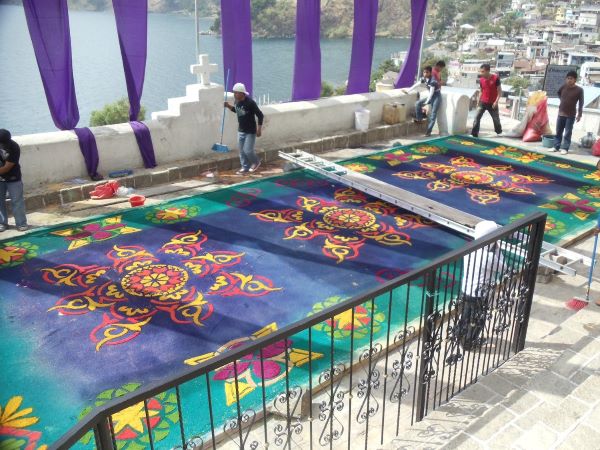Semana Santa | Holy Week is a vibrant and colorful celebration in Guatemala, and Lake Atitlan is one of the most spectacular places to experience it.
Here are some details:
Dates: Semana Santa | Holy Week changes dates every year, as it is based on the lunar calendar. In 2024, Easter falls on Sunday, March 31.
Celebrations: Each village around the lake has its own unique traditions, but some of the most common activities include:
- Processions: Elaborate processions with statues of saints and Jesus Christ are carried through the streets, accompanied by music and incense.
- Alfombras: Colorful carpets made from sawdust, flowers, and other materials are created on the streets, depicting religious scenes and symbols.
- Traditional foods: Special dishes like fiambre (a cold meat salad) and torrejas (fried pastries) are prepared and shared with family and friends.
- Religious services: Masses and other religious services are held throughout the week.
Villages to visit: Some of the villages around Lake Atitlan that are known for their Semana Santa | Holy Week celebrations include:
- Santa Catarina Palopó: This village is famous for its beautiful alfombras, which are made using dyed sawdust and other natural materials.
- San Antonio Palopó: This village is known for its large and elaborate processions.
- San Pedro La Laguna: This village has a more traditional Mayan feel to its Semana Santa celebrations.
- Santiago Atitlán: This village is known for its unique procession of the “Barco de Jesús” (Jesus’ boat).
Things to keep in mind:
- Semana Santa | Holy Week is a very busy time in Guatemala, so it is important to book your accommodations and transportation well in advance.
- Prices for hotels and tours can be higher during this time.
- Be respectful of the religious nature of the celebrations and dress modestly.
- It is customary to tip the people who carry the processional statues.
I hope this information helps you plan your trip to Lake Atitlan for Semana Santa!
The color purple holds significant meaning during Guatemala’s Holy Week, also known as Semana Santa. Here’s why:
Symbolism:
- Royalty: Historically, purple was associated with royalty and nobility due to the rarity and expense of producing the dye. This connection symbolizes Jesus’ status as the King of Kings in the Christian faith.
- Suffering: Later, purple became associated with suffering and mourning, representing the pain and sacrifice Jesus endured during his crucifixion.
- Penitence: During Semana Santa, the color reflects the penitential mood of the celebrations, as people reflect on Jesus’ sacrifice and seek forgiveness for their sins.
Traditions:
- Robes: Many participants in processions wear purple robes, signifying their penitence and respect for Jesus’ suffering.
- Decorations: Purple is often seen in decorations, like alfombras (colorful carpets on the streets) and banners, representing both the royalty and suffering aspects.
- Costumes: Traditional costumes of figures like “Cucuruchos” (hooded participants carrying incense) often incorporate purple elements.
So, the color purple plays a multifaceted role in Guatemala’s Semana Santa, serving as a reminder of Jesus’ royalty, sacrifice, and the penitential nature of the season.
Holy Week in Guatemala is celebrated with street expressions of faith, called processions, usually organized by a “hermandad“. Each procession of Holy Week has processional floats and steps, which are often religious images of the Passion of Christ, or Marian images, although there are exceptions, like the allegorical steps of saints.
To understand the current Guatemalan Holy Week one must go back to the religion of the Maya, where there were amazing coincidences that perhaps helped the Catholic religion fit more with the beliefs of Native Americans. One of these similarities is that indigenous Guatemalans used a palanquin to transport wealthy citizens and rulers



 Ethical Fashion Guatemala
Ethical Fashion Guatemala Ethical Fashion Guatemala
Ethical Fashion Guatemala